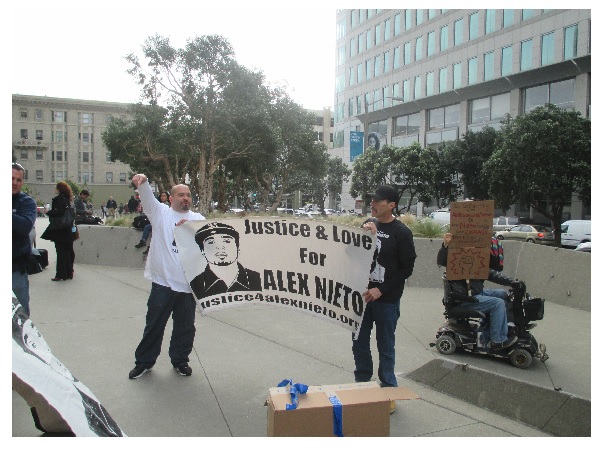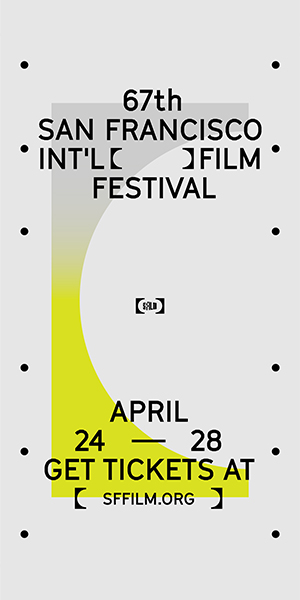“We are here today because of 59 shots,” Nieto family attorney Adante Pointer said, as he began his closing argument in the Nieto trial. “Fifty-nine shots that were fired on March 21st of 2014, by these four defendants Lt. Jason Sawyer and Officers Roger Morse, Richard Schiff and Nathan Chew, took the life of Alejandro “Alex” Nieto and the pride of his mother and father, Mr. and Mrs. Nieto.”
While Pointer presented an emotionally charged and strong closing argument, Deputy City Attorney Margaret Baumgartner kept her focus on trying to discredit eyewitness Antonio Theodore and asked the jury to look at physical evidence presented by Bryan Chiles, expert from Taser International. Absent from Baumgartner’s closing argument was any mention of Nieto himself, who was mostly referred to as “the man with the gun,” while she referred to the officers by their names and spoke of their families.
Pointer went through the timeline of the evidence and talked about the testimony of Evan Snow, one of the city’s star witnesses, who said Nieto pointed a Taser at him and his dog. Nieto, he said, only acted in that way because Snow’s Siberian husky chased him.
“The husky chased after Alex, who ran and jumped on top of a bench; even Snow said that his wolf dog was howling and acted erratically over the burrito in Nieto’s hand” he said. “But despite that, Snow never called 911, but he did admit to using racial slurs against Nieto during and after the incident, even repeating them here as if it was harmless of him to do so.”
Moving on to the testimony of Justin Fritz, the dog walker who called 911, Mr. Pointer remarked “Even Mr. Fritz, when he passed Mr. Nieto, said that nothing about him stuck out of ordinary; he wasn’t doing anything untowardly in the public park. In fact, he was doing something that was common and considered normal — he was enjoying the park.
“Nevertheless, he felt he saw a gun, and he called the police to do what any citizen would do. But you heard the 911 call — all he wanted was the police to investigate the issue.” Pointer then explained how Fritz described that he was 200 yards from Mr. Nieto but was able to observe him from the distance for the 911 operator.
“Please, remember there was another witness who was also the same distance away and said he saw the incident,” Pointer said while speaking of Theodore. So what did Fritz say to the operator?
“In a red jacket, probably 6 feet 1 inch, 200 pounds. It looks like he may be Hispanic.” and that Nieto was “kind of hanging out at the park.”
Pointer then urged the jury to remember that officers did not rush to the scene, and emphasized that Sawyer and Schiff responded to the situation while Sawyer, then a sergeant, was training Schiff.
While the officers were headed to the scene, Fritz continued to talk to the 911 operator, and admitted to the court that Nieto did not make him anxious because of his behavior.
At around, 7:13 pm, Fritz said that Nieto was pacing back and forth, not rushing, and that while one of his hand rested on what he thought was a gun, he was eating chips or sunflower seeds from the other. Pointer then explained to the jury that the first set of timestamps from laser expert Chiles don’t match the timeline provided by the police officers and that on his own admission, Chiles conducted the study after someone informed him that his timelines doesn’t match that of the cops.
“Nieto was walking down the hill; he was not marching on to his death like the officers claim” Pointer said. “The officers got there and they moved ahead on to the suspect. On the 911 call you can hear Sawyer say “I gotta guy right here.” It was 7:18 pm and 39 seconds; this is where the fateful moments of Alex’s life, unbeknownst to him, occurred. And while the officer’s say they asked him to show them his hands, no witness can corroborate that. But what you did hear a witness testif, is that the cops said “Stop!” prompting the rookie (referring to Schiff, who had been on the job less than three months) to start firing,” Pointer said, while he slapped his hands together four times signifying four shots.
“Please think about this, think of Alex pulling his jacket, pulling out his Taser and then pointing it to the officers while being hailed by bullets. The officers want you to believe that Alex, maintained a shooting position under the hail of 59 bullet. Let me recount, the bullets hit Alex’s forehead, mouth, shoulder, chest, burst his shin and were even in the spine. Now, Nieto was a lot of things to a lot of people but he was no Clark Kent, he was not Superman.”
The city’s story, he said, “flies in the face of reason, flies in the face of logic.”
Pointer told the jury that brain matter on the hat is evidence that Nieto was in fact wearing the hat when he was shot, similarly the bruise on his cheek were consistent with the idea that he may have been wearing his sunglasses. That’s important because Officer Schiff had earlier testified Nieto charged up at him, with his forehead visibly frowning, and he could see anger in his eyes.
Pointer referred to the city expert Craig Fries, who did the re-creations of the scene, as the “$40,000 man” referring to his fee, and reminded jurors of the fact that Fries took the stand to testify that he received photos of Nieto’s jacket, something that then Chief Medical Examiner Amy Hart denied ever existing.
Pointer elaborated that even the “$40,000 man” couldn’t answer a simple question: where did the bone fragment in Nieto’s pocket come from?
“Sometimes it’s the question that was not asked,” he said, recalling a quote from To Kill A Mockingbird. “People, generally, see what they are looking for and hear what they are listening for.”
“So when you see on your verdict forms, under the 4th Amendment, whether or not and how to award damages, think of Alex’s last moments. He was gurgling, eyes open; imagine the terror, the torture and the pain he may have felt. Instead he was handcuffed and his pulse checked. Imagine what it’s like to know that you’re essentially in the last throes of your life and you are alone,” Pointer said, as Alex’s parents, Elvira and Refugio Nieto, broke down on the front bench and held each other.
“You will be asked to award punitive damages, to award damages to Mr. and Mrs. Nieto. Because at the end of the day, Mr. Nieto was a security guard who contributed to the society. But what measure can you put on the life of a man, a son and a brother? this is a man with a huge smile that should have been wider” pointer said as he shook a bag with 59 coins to signify the bullets, pictures of Nieto’s family projected in the distance. “He was just a guy, just a guy, but to his family he was Alex.”
Baumgartner emphasized that Sawyer used the force that he felt that was necessary. “He used the force against ‘the man with the gun,’ that he thought was necessary so at the end of the day he could go back home to his wife,” she said.
“Under the Constitution, you need to consider the facts and circumstances, consider that the man held a gun and pointed at the officers. We now know that it was a Taser that couldn’t have hurt them. But jury instructions are careful and important. They didn’t know it was Taser at that time,” she said.
She urged the jury to put themselves in the shoes of Sawyer, “Who has worked for 20 years, to deal with these situations. Consider the limited information they had, the danger they thought they faced as the man pointed the gun at them and still maintained a shooting position as they shot at him. Consider these officers, who between them had hundreds of hours of training to make that decision, whether to use lethal force or not.”
She then referred to Nieto as an individual who “demonstrated his bully-ness and pointed at the gun at officers,” and emphasized that it was their duty to protect themselves. While talking about Snow’s testimony, Baumgartner said: “We don’t know why he pointed the Taser at Mr. Snow,” despite the fact that Snow himself testified that it was because his Siberian husky chased after Nieto. She then referred to Mr. Theodore as a non-credible witness because he was prejudiced; he had, in his deposition, referred to police brutality and referred to it as an “ongoing epidemic and genocide.”
Responding to the city’s own witness testimony that the Nieto’s Taser, as photographed on the scene, was turned off, Baumgartner said “We don’t know how the Taser was turned off, may be Mr. Nieto turned it off. We don’t know why it was turned off, maybe when Officer Morse kicked it, it got turned off.”
Baumgartner tried to avoid what many, not just one witness, see as an epidemic of police abuse: “This is about these officers and this case, this is not about any other cases that you may have heard or read about,” she said.
In rebuttal, Pointer left the jury with some questions he said he had and that the jury should think about. “There are many questions that I hope to hear answers from and I share them with you today: How did he get a bone in his pocket? how did the Taser get turned off and why did Officer Morse not see the red laser light? how did they get brain membrane on his hat, if he wasn’t wearing it? How come the officers failed to plan a tactical approach? Why did Mr. Chiles submit Taser timestamps if he did not believe they were accurate? Why does someone call and tell Chiles to recalculate because it doesn’t match? What could be eyewitness Theodore’s motive? How come these defendants lack a single witness to corroborate what they said took place at the time? Why did Alex not use the Taser on the dog that attacked him — but used it on the police? How did he survive each of his shot and still manage to hold the Taser at both hands? If this investigation was so pristine and transparent, why did Officer Schiff’s father come and speak to him before he gave a testimony? If they had hours of training, why did they not spend a few minutes planning a strategy?
The jury did not reach a verdict today, and will return to deliberate tomorrow.




